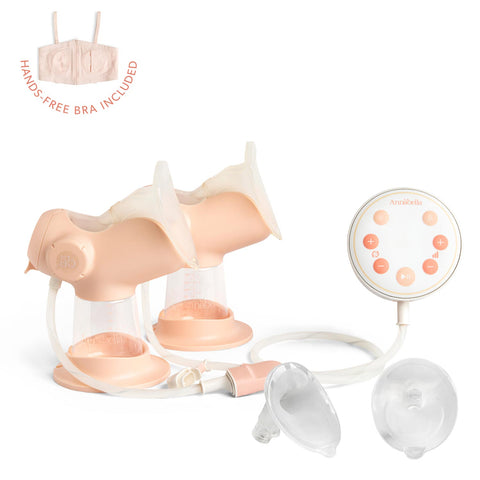Pumping breast milk is a highly individual experience; how your body responds to the pump depends on your unique breast and nipple anatomy, as well as your milk supply. For many, one particularly frustrating challenge arises when their nipples stretch excessively into the pump flange during expression. This phenomenon, often referred to as having "elastic nipples," can turn a routine pumping session into a perplexing and uncomfortable ordeal. Understanding what's happening and how to address it can help you achieve a more successful and satisfying pumping experience.
What Elastic Nipples Look Like
If you have elastic nipples, you've likely seen it in action. As your pump creates suction, your nipple and often a significant portion of your areola are pulled deeply into the flange's tunnel. It might stretch far down the flange, sometimes even touching the back of the tunnel. While some elongation is normal during pumping, excessive stretching is the hallmark of elastic nipples. The problem isn't just visual; it can lead to discomfort, pain, and, most frustratingly, low milk output, or even no milk expression at all. Despite what feels like powerful suction, the mechanism isn't effectively compressing the milk ducts, leaving you discouraged. You might adjust the suction up and down, change flanges, and still feel like you're fighting an uphill battle against your own body's natural stretchiness.
Finding Your Fit: Common Strategies for Elastic Nipples
Before diving into pump-specific solutions, it's helpful to understand general strategies that can improve pumping for those with elastic nipples. Flange sizing is almost always the first point of investigation. While intuition might suggest a larger flange to accommodate the stretch, often the opposite is true. A flange that is slightly too large can pull in too much areola, creating more elastic pull. Conversely, one that is too small can pinch the nipple, leading to pain and reduced milk flow. Finding the absolute perfect fit, which might be smaller than you expect, is your first step. Many mothers benefit from trying different flange sizes to find the one that allows the nipple to move freely without excessive tugging on the areola. Lubrication, such as nipple cream or coconut oil, applied to the flange tunnel before pumping, can also help reduce friction and prevent the nipple from sticking or stretching uncomfortably. Some also find that starting with a gentle massage or hand expression before attaching the pump can help initiate let-down and improve milk flow. Finally, beginning with a lower suction setting and gradually increasing it after let-down can prevent the initial harsh pull that exacerbates nipple elasticity.
Taming the Stretch with Annabella: Specific Techniques
For Annabella pump users experiencing elastic nipples, several tailored strategies leverage the pump's unique features to enhance comfort and milk expression. These techniques aim to achieve a more effective, gentle grip on the nipple while minimizing excessive stretching.
1. Hold the breast tissue to prevent a too much of it from being sucked into the pump: Holding the breast tissue at the base of the flange, gently pushing it inward towards the nipple, can help to improve pumping with elastic nipples. This physical manipulation prevents excess areola from being pulled into the tunnel, allowing the pump's suction and "tongue" mechanism to focus more effectively on the right part of the nipple areola complex. This reduces the overall stretch on the elastic tissue and ensures a more efficient milk extraction.
2. Using the tighter tongue positions – 3 or 4 – to have a close grasp on the nipple: Annabella's innovative "tongue" feature offers unique control. By using the tighter tongue positions, specifically 3 and 4, you create a firmer, more contained grasp around the nipple. This tighter embrace mimics a baby's latch, which is crucial for efficient milk removal. When the "tongue" has a close grasp, it can more effectively compress the milk ducts located behind the nipple, leading to better milk flow even with elastic tissue.
3. Using a lower vacuum setting, maximum 5-7, so not too much of the nipple is pulled in:
Third, using a lower vacuum setting, typically maximum 5-7, is counterintuitive but highly effective. While one might think higher suction would extract more milk, for elastic nipples, it often just pulls more tissue further down the tunnel without effectively compressing the ducts. A lower vacuum reduces this excessive pull, keeping the nipple closer to the base of the flange, where the "tongue" can work optimally. This minimizes discomfort and allows for more productive pumping.
4. Using fast tongue speed:
Using a fast tongue speed can be beneficial. Faster cycles can stimulate more let-downs and maintain a consistent, rhythmic compression that encourages milk flow without prolonged, static suction on the nipple. This quick, efficient action helps prevent the nipple from remaining stretched for too long, reducing discomfort and maintaining effective stimulation.
5. Pumping each side individually for no more than 5 minutes to maximize milk expression:
Pumping each side individually for no more than 5 minutes is a power-pumping technique tailored for Annabella and elastic nipples. The goal here is to maximize the initial rush of milk from each let-down. Elastic nipples may respond better to short, intense bursts of pumping rather than prolonged, continuous suction. By switching sides frequently after a few minutes, you capitalize on the let-down reflex from both breasts and then rotate, ensuring maximum milk expression per session without over-stretching the nipple. This also encourages multiple let-downs across the session, optimizing overall yield.
A Path to Pumping Comfort
Dealing with elastic nipples can be frustrating, but it doesn't have to be a permanent roadblock to meeting your breastfeeding goals. By understanding the unique way your body responds to the pump and by applying these tailored strategies for your Annabella, you can transform your pumping experience. Patience, experimentation with these settings, and a willingness to adapt your technique are your way forward. Every drop of milk counts, and finding comfort in your pumping routine is a victory in itself.







